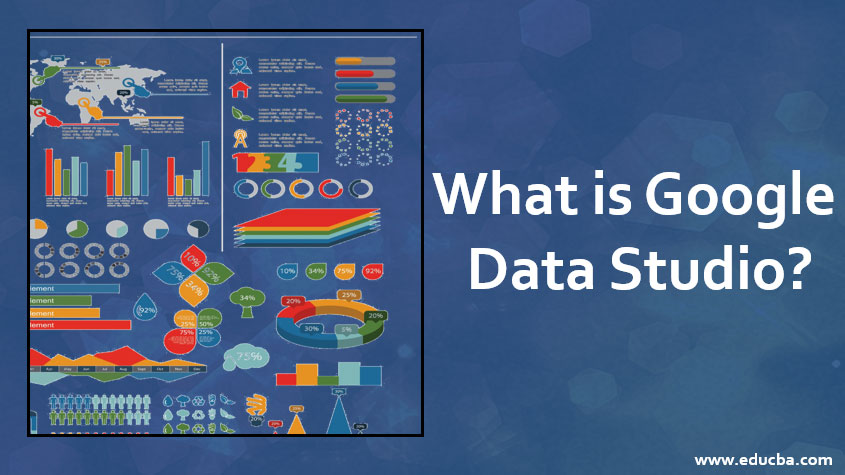Updated March 23, 2023

Introduction to Google Data Studio (GDS)
You can create branded reports with data visualizations to share with your customers through Google Data Studio. For most digital marketers, analytics has always been a challenge. The reports can be read easily, circulated easily, and tailored to each of the customers. The way to show the data, graphs, bar charts, line charts, and so on — is to be chosen. Also, font and colour changes and reports can be identified by your logo. It can be overwhelming, compelling, and, quite honestly, hard to understand and interpret for ordinary people.
What is Google Data Studio?
Looking into the history of GDS in Cloud Services, technically, it is launched in mid-2016 and later with a Beta version in 2018. Earlier, it was picked by many Analysts with the hype of tools,s and then later, with the fixation of the bugs and modifications done by Google, this has become one of most happening and recommended tools for Analysts as a free open source to go with.
For beginners, this tool welcomes you to have a good understanding and exposure to report building. However, for all those who were already aware of this, knowing this as an online reporting tool, there is something extra you need to know, i.e., it is of very few tools that provide advanced charts and a collaborative work nature where multiple analysts from different places can sit and work on the single Dashboard or Report having improvement history aside. Isn’t this sounding cool?
Why Should you Work on GDS?
You can work on many tools like Tableau and Power BI, etc., but the thing is that they all are premium, and Google’s Data Studio is free; all it needs is logging in with Google’s credentials. Using GDS, one can perform many types of flexible Reports using charts, tables such as Time series, Pie charts, Line, Area, and Scatter charts. In addition, this cloud tool has access to advanced charts to input Sunburst, Gantt, Radar, and Gauge Charts, which comes under community visualization; this adds more value for any dashboard.
These advanced charts will transform any complicated dataset and variables into an effective and simplest understanding Report. Learning and having these charts on report makes you a Professional Report builder and leads to build meaningful and most beautiful Dashboards. Ideally, let’s see how a usual Report looks like having KPIs on top, charts on the second row, tables and trends beside each other on the bottom, making it an effective and comprehensive one. Same way, a proper colour combination, and preferences according to end customers may become preferable to end-users.
Especially if you are a Startup or freelancer, this is the best pocket-friendly tool to pull out Analytics in the best form and deliver it to your end customer. It would allow you to save the budget and manage well in the Project. Believe it or not, there are more than 60% of Startups and Freelancers depend on this Google Data Studio to perform Reporting.
How does this GDS Work?
We all know that Google is a cloud-based Product, and the Services provided are the same, where it needs the internet; of course, like Google sheets, you can still access it offline. However, GDS works over the internet; click on
datastudio.google.com to see how it looks. Once you’re logged in, then Google suggests you go through the template gallery where all the pre-defined reports are generated and kept for reference; this is a good way to start, especially for a beginner. Now, you may have an idea, what is and how does this works.
If at all, you want to experiment by starting with a new report, click on a blank Report(+) and connect to your data source, either a local machine file (CSV, Excel) or online data source (AdWords, Google Analytics, etc.) and pull the dimensions (Date, Name) and measures (Clicks, Impressions) on the right side of the Report and drag the type of on you wish to see. Once you have figured out what is needed, place it all in one place side by side or top to the bottom. If you are working with your peers, provide them access by clicking on the share. Together, you can comment on reports or chat over hangouts to communicate on how to work and finalize it? That’s it; you are good to go!!
Advantages of Working Over GDS
- Firstly, it’s FREE of cost and user-friendly.
- Pre-defined reports are given for a walkthrough and better understanding.
- Different data sources can be connected and merged easily.
- Unlike other tools, a simple drag and drop would create a chart.
- Buttons are simple and straight to the usage—no confusion about switching between the options.
- The most effective and beautiful charts can be generated over GDS. Using advanced charts where complicated datasets would bring down results to the simplest understanding.
- Easily shared with peers to co-work. As we all know that collaborating and working together would give a fruitful result.
- Access can be defined while sharing; another person can or cannot modify upon your wish. I know this gives you pride in working.
- Reports are completely secure over GDS, as there is password protected. Especially when sharing with your end Customer.
It doesn’t take much effort to open and show to your Manager. Just like easy peasy, lemon squeezy!!
Then what? Sign in today, give a shot by pulling the data from wherever dataset you wish, and drag/draw the necessary charts to prepare a customized report. Is that simple!!
Recommended Articles
This is a guide to What is Google Data Studio? Here we discuss the introduction, why should you work on GDS and advantages. You can also go through our related articles to learn more –
